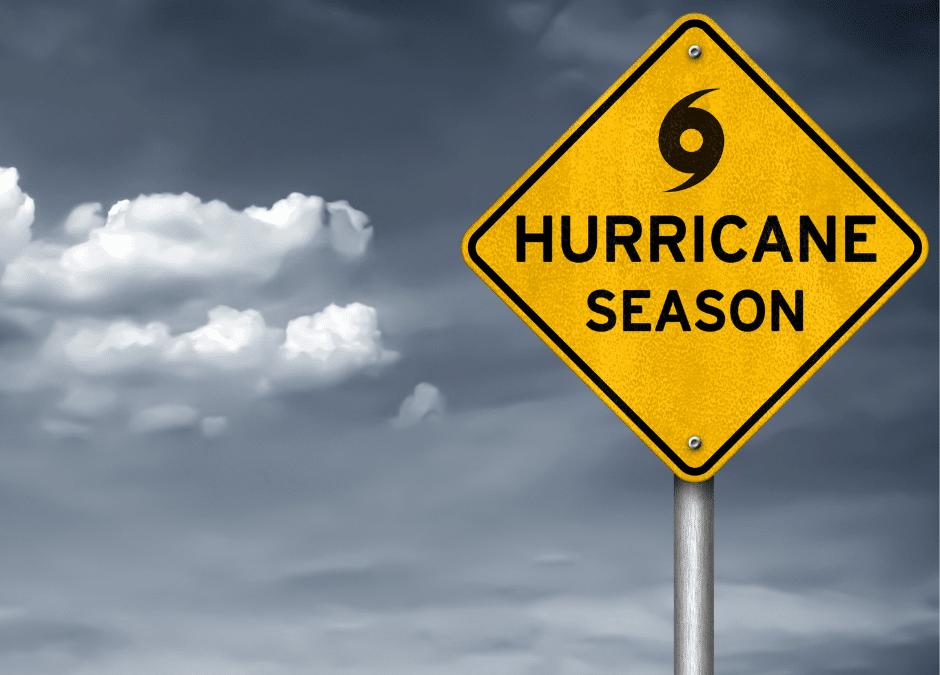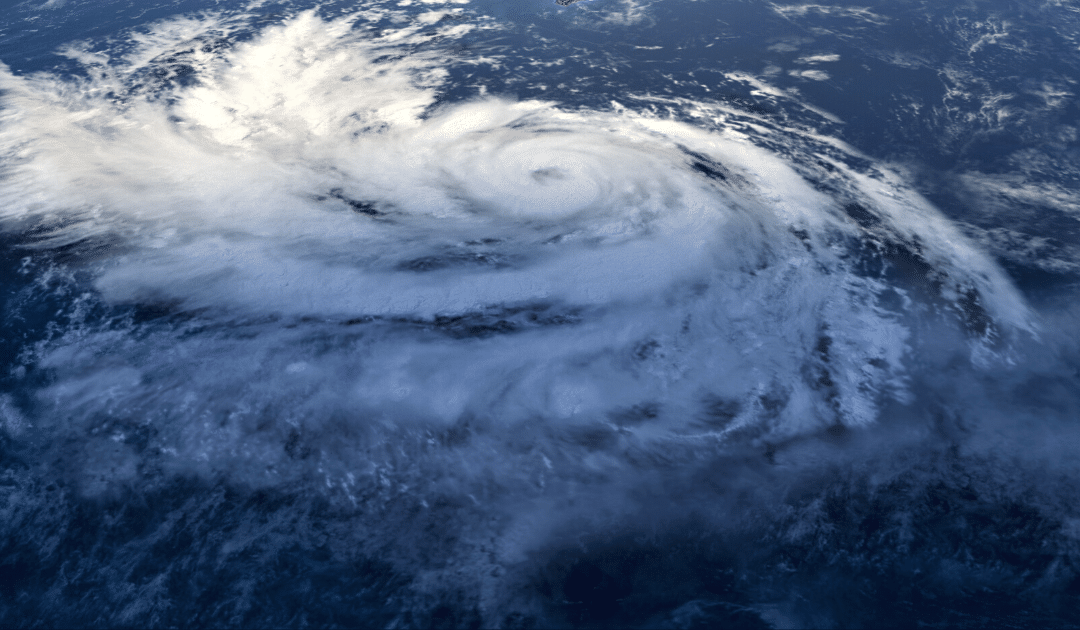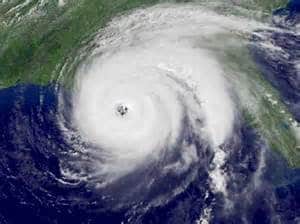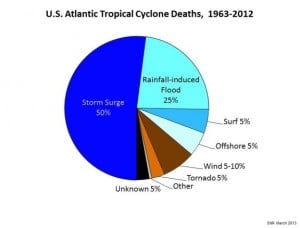
by California Casualty | Homeowners Insurance Info, Safety |
Hurricanes are natural disasters that bring demolishing winds and massive amounts of rainfall to land from the ocean. Coastal towns and cities across the world have been torn apart by hurricanes, but they aren’t the only ones who are usually affected. Hurricanes can cause significant damage to towns over 100 miles inland! September, is the most active month of the year, so now is the time to protect yourself and your family from these deadly natural disasters.
The relative lack of storms so far this hurricane season is bringing both good and bad news. While we are all taking a sigh of relief that there has yet to be a major storm, it could also be bringing a false sense of security. Many people in states where hurricanes usually hit may be “dropping their guard.” A new survey finds only a quarter of those living in hurricane-prone states think they are prepared if a monster storm hits, and nearly half of the respondents say they have yet to make any preparations this year.
Remember all hurricanes, no matter what size, have the potential to cause significant damage and life-threatening situations. Looking back at the destruction previous hurricanes like Harvey, Sandy, and Katrina have caused, it is essential that you make sure your family, home, and belongings are completely protected.
Important Hurricane Coverages:
- Flood Insurance. A regular home insurance policy will not pay for damages caused by flooding, but when you add flood insurance to your policy it will cover all damages that happen to your property, even if you rent! Be aware that when you add flood insurance there is a 30-day waiting period until it goes into effect, so that means it is often too late to purchase it when a hurricane or tropical storm is approaching.
- Scheduled Personal Property Insurance (Floater). Many people find that after a natural disaster their insurance coverage is limited on expensive personal items (ex. jewelry, furniture, technology, firearms, collectibles, furs, instruments, etc.). Floaters protect your personal items for their full value.
Steps to Protect Your Home & Family
- Heed evacuation notices and keep your car’s gas tank full in case of evacuations
- Stock up on essentials like bottled water, non-perishable food items, toilet paper, and pet food
- Make sure pets are kept inside, safe, and have a spot to do their “business”
- Have a family evacuation and communication plan
- Prepare an emergency kit (ex. flashlight, medicines, cash, and important documents)
- Get a NOAA Weather Radio
- Sign up for National Weather Service storm texts at https://www.weather.gov/subscribe-hurricaneinfo
- Charge cell phones and other devices and have charged spare batteries
- Install storm shutters or purchase 5/8 exterior grade or marine plywood to cover windows or doors
- Add straps or additional clips to roofs to reduce damage
- Bring in or secure anything that can be propelled by wind (ex. grills, bicycles, lawn furniture, play equipment, etc.)
- Know how to turn off propane tanks and gas lines
After a Hurricane Strikes
- Make sure you, your family, and pets are safe and secure
- Register yourself as “safe” on the Safe and Well website
- Follow all city boil and curfew orders
- Secure the property from further damage or theft
- Contact your insurance company as soon as possible
- Keep or document receipts and other expenses if you are evacuated or forced to find another place to live because of damage to your home or apartment
- Be wary of unscrupulous contractors following a natural disaster
It’s important to know that flooding and storm surge are the biggest threats to life when hurricanes hit. Leave low-lying areas, never drive or cross through running water, and avoid rivers, streams, and creeks; which could flash-flood.
For more information visit:
https://www.ready.gov/hurricanes
https://mycalcas.com/?s=hurricane
https://www.iii.org/article/preparing-hurricane
https://www.cdc.gov/features/hurricanepreparedness/index.html
https://www.redcross.org/get-help/how-to-prepare-for-emergencies/types-of-emergencies/hurricane.html
This article is furnished by California Casualty, providing auto and home insurance to educators, law enforcement officers, firefighters and nurses. Get a quote at 1.866.704.8614 or www.calcas.com.

by California Casualty | Safety |
Do you know the difference between a Category 2 and 3 hurricane? Do you know why a 5 is so bad? Are you clear on what safety precautions you’d need to take when expecting a Category 2 versus a 4?
Read on to better understand what the 5 hurricane categories really mean and what impacts each can bring to your home and community. Understanding the details will help you think through how to better prepare for hurricane season.
It’s All About the Wind Speed
The category numbers — 1 through 5 — come from the Saffir-Simpson Hurricane Wind Scale. Meteorologists rely on this scale to better understand a hurricane’s expected magnitude and predict the damage that will come when the storm makes landfall.
Ratings focus on sustained wind speed for the simple fact that with higher wind speeds come more damage — not only direct wind damage but also storm surges, rain-induced flooding, tornadoes, and more.

-
- Wind speeds: 74-95 mph
- Danger level: Very dangerous winds will produce some damage.
- Threat to homes, structures, and property: Winds can damage roof, shingles, siding, and gutters on well-built framed homes. Trees may topple and branches snap off. Protected glass windows generally remain intact.
- Community impacts: Potential damage to power lines and poles, leading to short-term power outages.
- Take note: Injuries to people and animals are limited and typically come from flying debris.

-
- Wind speeds: 96-110 mph
- Danger level: Extremely dangerous winds will cause extensive damage.
- Threat to homes, structures, and property: Framed homes susceptible to major roof and siding damage.
- Community impacts: Near-total power loss expected with outages lasting days to weeks. Significant structural damage to mobile homes, apartment buildings, and shopping centers. Flooding of low-lying areas is possible.
- Take note: Stock up on filtration systems for potable water.

-
- Wind speeds: 111-129 mph
- Danger level: Devastating damage will occur.
- Threat to homes, structures, and property: Major damage and/or removal of roof decking and gables possible on well-built framed homes. Mobile homes and poorly constructed homes are often destroyed. Many trees will be uprooted or snapped, blocking roadways.
- Community impacts: Water and electricity unavailable for days to weeks after the storm passes. Extensive inland flooding is possible.
- Take note: Make sure to be well-stocked with food and water if you choose not to evacuate.

-
- Wind speeds: 130-156 mph
- Danger level: Catastrophic damage will occur.
- Threat to homes, structures, and property: Well-built framed houses subject to severe damage, including loss of most of the roof and/or some exterior walls. Shopping centers and apartments also typically sustain severe structural damage.
- Community impacts: Power outages will last weeks to months. Neighborhoods in the strike zone will be uninhabitable for weeks or months.
- Take note: Sheltering in place is typically not recommended, but if you do, ensure you have a good supply of food, water, medications, etc.

-
- Wind speeds: 157 mph or higher
- Danger level: Catastrophic damage will occur.
- Threat to homes, structures, and property: Complete or almost-total destruction of framed homes, mobile homes, shopping centers, apartments, and commercial buildings.
- Community impacts: Nearly all trees will be snapped or uprooted, with many becoming airborne and acting as projectiles. Long-term water shortages should be expected, as well as a very long time to rebuild the community. The area will be uninhabitable for weeks or months.
- Take note: You should not be anywhere near this storm. Evacuate well ahead of time.
As with any natural disaster or extreme weather event, make sure you stay informed via local news and weather alerts. Listen for and follow evacuation orders.
Read our guides on how to prepare for hurricane season, pack an emergency kit, and what to do after a natural disaster.
Finally, remember that although the best hurricane preparations come well before hurricane season itself, it’s never too late to get informed and prepared.
This article is furnished by California Casualty, providing auto and home insurance to educators, law enforcement officers, firefighters, and nurses. Get a quote at 1.866.704.8614 or www.calcas.com.
by California Casualty | Homeowners Insurance Info |
 Hurricane season began June 1. Are you ready? The nation’s top emergency managers warn that millions of Americans from the Gulf Coast to the Eastern Seaboard as far north as Maine are in danger. Southern California has even experienced tropical storms, giving the West Coast a reason to be concerned.
Hurricane season began June 1. Are you ready? The nation’s top emergency managers warn that millions of Americans from the Gulf Coast to the Eastern Seaboard as far north as Maine are in danger. Southern California has even experienced tropical storms, giving the West Coast a reason to be concerned.
While hurricanes are associated with extreme winds, the National Hurricane Center warns that storm surge actually causes the most damage and loss of life.  The Federal Emergency Management Agency (FEMA) has developed new maps to show the danger. They also have a list of hurricane preparedness tips that include:
The Federal Emergency Management Agency (FEMA) has developed new maps to show the danger. They also have a list of hurricane preparedness tips that include:
- Prepare an emergency kit
- Have a family evacuation and communications plan
- Install hurricane shutters or stock up on boards 5/8 exterior grade or marine plywood to cover windows and doors
- Install straps or additional clips to roofs to reduce damage
- Have a NOAA Weather Radio
- Be prepared to bring in anything that can be picked up by wind (bicycles, lawn furniture, play equipment, grills, etc.)
- Know how to turn off propane tanks and gas lines
- Keep your car’s gas tank full in case of evacuation
Are you covered if a hurricane strikes? The insurance industry recommends everyone take these steps:
- Learn how you can mitigate damage from wind and flooding associated with hurricanes
- Begin or update your home inventory (knowyourstuff.org)
- Understand your insurance – know whether you have actual cash value or replacement cost coverage, know how much living expenses coverage you have and make sure you have flood insurance (not covered with most home or renters insurance)
- Store copies of your inventory and insurance information in a safe location away from home
- Get an annual insurance review to make sure you have enough coverage for the dwelling and possessions
And here is what to do if there is damage to your property:
- Contact your insurance company as soon as possible
- Secure the property from further damage or theft
- Keep or document receipts and other expenses if you are evacuated or forced to find another place to live because of damage to your home or apartment
- Be wary of unscrupulous contractors following a natural disaster
California Casualty is ready to help before or after the storm. Contact an advisor today for a policy review, to arrange for flood insurance or upgrade coverages at 1.800.800.9410 or visit www.calcas.com. It’s also our policy to call customers in a disaster area to make sure you are okay and help start a claim, and our Claims department is available 24 hours a day, even on holidays if you have an emergency.
Resources for this article:
https://www.ready.gov/hurricanes
https://www.redcross.org/prepare/disaster/hurricane
https://www.fema.gov/national-flood-insurance-program-flood-hazard-mapping
https://www.nhc.noaa.gov/prepare/
https://viewer.zmags.com/publication/698e58a3#/698e58a3/1
This article is furnished by California Casualty, providing auto and home insurance to educators, law enforcement officers, firefighters and nurses. Get a quote at 1.800.800.9410 or www.calcas.com.
by California Casualty | Safety |
As Hurricane Sandy whirls her way ashore–teaming up with winter storm conditions and a full moon as she does so–it’s becoming more and more clear that this storm has the potential to be extremely dangerous and damaging to communities all along the East Coast.

Late last week, we posted tips on how to prepare your family, self, and home for Hurricanes and Winter Storm conditions. To access that information–including checklists, preparation plans and pet and business info–click here.
As Sandy begins to make landfall, we want to make sure all those affected know where to get up-to-date, reliable information regarding evacuations, weather updates, and other emergency information.
Here are some emergency resources:
- This Google Crisis Map tracks Sandy’s progress, providing forecast tracks, current locations and active emergency shelter locations. Access the map here: Google Crisis Map.
- For the latest updates on Hurricane Sandy from the National Hurricane Center, click here.
- For a map of the latest warnings and advisories from the National Hurricane Center, click here.
- For state-specific information, click on YOUR state below:
- CT
- DE
- MA
- MD
- ME
- NC
- NH
- NJ
- NY
- New York City
- PA
- VA
- VT
- If you lose power or Internet signal and need to access Twitter to get Emergency Information, click here for tips on how to do so with your phone. For the Huffington Post’s suggestions on the Best Storm Tracker Apps, click here. We recommend following @FEMA to stay informed.
- It can be difficult to stay in touch with or reach family members during an emergency. The American Red Cross Safe and Well website allows you to register your current status or check on the status of your loved ones.
- To download the Free FEMA app for disaster safety tips, emergency meeting location information and a map of open shelters, click here.
As Sandy makes her way onto land, all those affected are in our thoughts. Please be smart and safe.
by California Casualty | Homeowners Insurance Info |
Hurricane season is here, and with it comes the risk of damaging storms in coastal areas. While your primary goal should be emergency supplies and an evacuation plan to keep you and your family safe, there are also some steps to take to protect your home from catastrophic damage.
One of the biggest keys to protecting your home from damage is to secure the windows. Why is this important? For one, once the windows shatter, the high winds enter the house, wreaking havoc and causing interior damage. The most important reason is that as hurricane winds blow into the house, it creates upward pressure on the roof. This pressure may be enough to blow the roof off – which will likely lead to the total destruction of your home.
The ideal way to protect your windows is to install heavy duty wood or metal storm shutters. This can be quite an investment, but one that will pay off in protection, as well as the ability to quickly respond to the threat. Alternatively, you can use marine plywood attached to your home’s exterior. It is recommended that you have these pieces purchased, cut, and pre-drilled/ready to install before a hurricane watch is in place. If you wait until danger is bearing down on you, it may be too late.
Some other tips to protect your home during a hurricane:
- Remove dead trees or tree limbs on your property
- Be aware if your home is in a storm surge danger area
- Create a “safe room” in your house
- Keep battery powered radios, flashlights, and extra batteries on hand.










